- François Denhaut
Infobox Person
name = François Denhaut

residence = flagicon|FranceFrance
occupation = Pilot,inventor ,aviator François Denhaut was a French pilot notable for designing, constructing and flying the first
flying boat , orseaplane with a hull, in 1912.Nicolaou, p.17]Little is known about Denhaut before he built the flying boat; he was born close to the end of the 19th century, and he was the chief pilot of
Pierre Levasseur 's flying school. [Parrochia, p.130]1911 Model
The endeavour to build a flying boat began following Denham's construction, in 1911, of a seaplane with a hull. This design marked one of the first large steps forward in marine aviation, and constituted a pioneering leap in this area. The hull was triangular in shape, with the point at the top. To achieve successful hydrodynamic lift, the hull was fitted with styled lift off plates. It had a Gnomic convert|50|hp|abbr=on engine that was of a unique make, and which drove the pusher
propeller , and which was placed up high, behind the pilot seat. To allow for maneuvering on the ground, an undercarriage was designed and fitted in, with two wheels attached.Parrochia p.131] Denhaut took particular advantage of this aspect of the design when he made the initial tests by taking off from the ground. This project was financed by Jacques Donnet, [Cahisa, p.227] and the craft was later named after him.The first proper test of the craft took place on
March 12 ,1912 . Denhaut took off fromPort Aviation , and flew over theRiver Seine . However, when they were preparing to land, the plane didn't straighten out properly, and the plates were submerged under the water while the plane was still flying. Denhaut braked suddenly, and the whole plane flipped. Denhaut managed to escape from the waterloggedcockpit , and took refuge on the bottom of the hull. The craft was hoisted back to shore. [Noetinger, p.323]1912 modifications
Denhaut, with the advice of
Robert Duhamel , decided to rebuild the plane, making the necessary modifications to the first design model. He changed the hull to be rectangular in shape, and thus flat-bottomed, because it had previously been very slender, and had tended to dip into the water. He also made slight modifications to the position of the undercarriage.He tested the modified design on a stretch of water behind Port Aviation, where he had first tested the older model. After this test, the wheels were, temporarily, replaced with water floats.
On
April 13 1912 , slightly over a month since the initial test of the first design, Denhaut's craft flew fromJuvisy airfield , and landed on muddy ground close to the River Seine. After being pushed into the water gently, the plane took off and alighted seven or eight times. Denhaut then returned to the bank of the River Seine. Denhaut's second model had succeeded in becoming the world's first flying boat. Many later designs for flying boats can be seen to be very clearly based upon Denhaut's design.Notes
References
*citebook|first=Stéphane|second=Nicolaou|title=Flying Boats & Seaplanes: A History from 1905|publisher=Zenith Imprint|year=1998|isbn=0760306214
*citebook|first=Daniel|last=Parrochia|title=L'homme volant: philosophie de l'aéronautique et des techniques de navigation|Publisher=Editions Champ Vallon|year=2003|isbn= 2876733676
*citebook|first=Jacques|last=Noetinger|title=Rencontres des hommes et des ailes au Musée de l'air et de l'espace|Publisher=Editions France Empire|year=1989
*citebook|first=Raymond|last=Cahisa|title=L'aviation d'Ader et des temps héroïques|Publisher=Michel|year=1950
Wikimedia Foundation. 2010.
